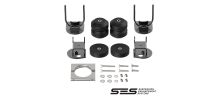When it comes to towing, achieving the perfect alignment is essential for safety and efficiency on the road. One often overlooked factor is trailer hitch height. It plays a crucial role in ensuring your trailer and vehicle sync during transit. The correct hitch height ensures that weight is distributed evenly, preventing issues like trailer sway and uneven tire wear. Finding the ideal height for your trailer hitch can be the difference between a smooth and challenging journey.
Rigid Hitch Inc.: Your Partner in Achieving the Perfect Alignment
Rigid Hitch Inc. is your go-to destination for achieving the perfect alignment in towing. We understand the critical role that trailer hitch height plays in safe and efficient towing. That's why we offer a wide range of Receiver Hitches designed to provide the right height and alignment for various towing scenarios. Our commitment to quality ensures that you have access to reliable towing solutions, whether you're an individual embarking on a weekend adventure or a business with heavy-duty hauling requirements. With Rigid Hitch Inc., you can trust that your towing experience will be smoother and safer, thanks to our high-quality products.
The Crucial Role of Hitch Height
The importance of trailer hitch height in the towing world cannot be overstated. It serves as the linchpin of a successful and safe towing operation. Hitch height ensures that the trailer and tow vehicle are in perfect alignment, creating a harmonious connection that facilitates stable and controlled towing. When the hitch height is set correctly, the weight distribution between the tow vehicle's axles and the trailer's axles is optimized, preventing issues like trailer sway and fishtailing. The hitch height acts as the pivot point around which the trailer rotates during turns and maneuvers. This crucial alignment contributes to overall towing stability, making it an indispensable factor in towing safety.
Understanding Trailer Hitch Height
Trailer hitch height refers to the vertical distance from the ground to the center of the hitch receiver on the tow vehicle. This measurement is pivotal because it must match the height of the trailer's tongue when it is level. Achieving this alignment is a fundamental aspect of safe and efficient towing. When the hitch height aligns with the trailer's tongue height, the trailer's weight is evenly distributed between the tow vehicle and the trailer itself. This balance is a key contributor to towing stability and control. Furthermore, proper hitch height minimizes the risk of uneven tire wear, brake issues, and other complications from an improperly aligned setup.
The Impact of Hitch Height on Towing Stability
One of the critical factors influencing towing stability is the hitch height. The hitch height determines how level the trailer is when connected to the tow vehicle. If the hitch height is not appropriately set, it can lead to a range of stability issues that can jeopardize safety on the road.
If your hitch height is too high, the front of the trailer will tilt upward, transferring more weight to the rear axles of the tow vehicle. This can result in poor weight distribution, reduced traction on the front wheels, and diminished braking efficiency. Additionally, it can lead to the dreaded phenomenon known as trailer sway, where the trailer oscillates from side to side, making it challenging to control the rig.
Conversely, if the hitch height is too low, the front of the trailer will point downward, potentially placing excessive weight on the tow vehicle's front axle. This can lead to reduced rear-wheel traction, difficulty steering, and compromised braking performance. An imbalanced setup with a low hitch height can also result in trailer sway, making it difficult to maintain control while towing.
Finding the Ideal Hitch Height for Safe Towing
The process begins by measuring the height of your trailer's tongue on a level surface. This measurement represents the target hitch height. You can then adjust the hitch height on your tow vehicle to match this measurement, achieving a level connection between the trailer and the tow vehicle.
It's important to note that the ideal hitch height may vary depending on the type of trailer, the weight being towed, and the characteristics of the tow vehicle. Manufacturers often provide guidelines for hitch height, and following their recommendations for your specific equipment is essential.
By paying careful attention to hitch height and ensuring that it's correctly set for your towing setup, you can significantly enhance towing stability and safety on the road. Proper hitch height alignment minimizes the risk of trailer sway, improves weight distribution, and optimizes braking performance, allowing you to tow with confidence and peace of mind.
Safety Considerations When Setting Hitch Height
First, always consult your trailer and tow vehicle manufacturer's recommendations for the appropriate hitch height. These guidelines are specific to your equipment and provide essential safety information.
It's essential to use a high-quality hitch rated for your towing needs and meets safety standards. Ensure that the hitch receiver and ball mount are in good condition and properly secured. Regularly inspect these components for wear and damage and replace them if necessary. Using safety chains and adequately connecting them to your tow vehicle is crucial. Safety chains act as a backup if the trailer becomes disconnected from the hitch. Cross the chains under the trailer tongue and attach them securely to the tow vehicle's frame.
Another safety consideration is the proper setup of weight distribution systems or sway control devices if required for your towing setup. These systems help distribute the weight evenly across the tow vehicle and trailer, enhancing stability and control. Follow the manufacturer's instructions for installation and adjustment, and check them regularly for wear and proper functioning.
Tips for Maintaining Proper Hitch Height
To maintain proper hitch height and alignment, regularly inspect your towing equipment and make any necessary adjustments. If you change trailers or tow vehicles, ensure that the hitch height is appropriate for the new setup. When hitching your trailer, double-check that the hitch ball and coupler are securely connected, and the safety pin or locking mechanism is engaged.
Consider investing in a high-quality hitch with adjustable height settings, which can be particularly useful if you frequently tow different trailers. These adjustable hitches allow you to fine-tune the hitch height for each towing situation, ensuring the best alignment and safety.
Regular maintenance of your towing equipment, including lubricating moving parts and checking for signs of wear, is essential to ensure safe towing. Additionally, always inspect safety chains, wiring harnesses, and other components for any issues before hitting the road.
By adhering to these safety considerations and implementing proper maintenance practices, you can maintain the correct hitch height and ensure a safe and secure towing experience. Prioritizing safety protects you and your passengers and other road users, making towing a responsible and reliable way to transport your cargo.
Take Action with Rigid Hitch Inc.
Ready to achieve the perfect alignment for your towing needs? Rigid Hitch Inc. invites you to explore our selection of Receiver Hitches and towing accessories. Our products are designed to cater to a wide spectrum of towing requirements, ensuring you can confidently tow. Don't compromise on safety and efficiency. Visit Rigid Hitch Inc. today and discover the difference the right trailer hitch height and alignment can make in your towing experience.







